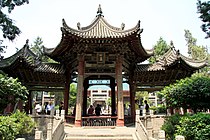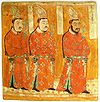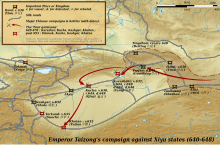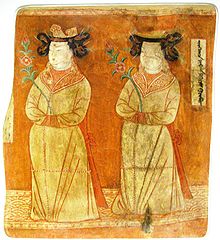User:Toomuchcuriosity/sandbox
Edits to Turkic settlement of the Tarim Basin
[edit]| This user page may require cleanup to meet Wikipedia's quality standards. The specific problem is: jumbled text, repetitions, extensive bias, and other material of marginal relevance. Please help improve this user page if you can; the talk page may contain suggestions. |
| Part of a series on Islam in China |
|---|
 |
|
|
| History of Xinjiang |
|---|
 |
Turkic peoples began settling in the Tarim Basin in the 7th century. The first settlers were likely Tang-allied Türk (Tujue) tribes. The area was later settled by the Uyghur people, who founded the Qocho Kingdom there in the 9th century.[1] The historical area of what is modern-day Xinjiang consisted of the distinct areas of the Tarim Basin (also known as Altishahr) and Dzungaria. The area was first populated by Indo-European Tocharian and Saka peoples, who practiced Buddhism. The Tocharian and Saka peoples came under Chinese rule in the Han dynasty as the Protectorate of the Western Regions due to wars between the Han dynasty and the Xiongnu and again in the Tang dynasty as the Protectorate General to Pacify the West due to wars between the Tang dynasty and the First, Western, and Eastern Turkic Khaganates. The Tang dynasty withdrew its control of the region in the Protectorate General to Pacify the West and the Four Garrisons of Anxi after the An Lushan Rebellion, after which the Turkic peoples and the other native inhabitants living in the area gradually converted to Islam.
Tarim Basin
[edit]
The Tarim Basin, populated by the Indo-European Tocharian and Saka, became the place of settlement by two different Turkic Kingdoms, the Buddhist Turkic Uyghur Kingdom of Qocho and the Muslim Turkic Karluk Kara-Khanid Khanate. Following the division of the Mongol Empire, control of the region frequently shifted between different rulers.[2]
The Turfan and Tarim Basins were populated by speakers of Tocharian languages,[3] with "Europoid" mummies found in the region.[4] The oases were populated by Iranian and Tocharian language speakers.[5] Different historians suggest that either the Sakas or Tokharians made up the Yuezhi people who lived in Xinjiang.[6] The northern Tarim Basin is where Tokharian language records were found.[7]
The inhabitants of the Tarim Basin consisted of Buddhist Indo-Europeans, divided between Tocharians and Eastern Iranian Sakas.
Historical Context
[edit]Han and Tang rule
[edit]
During the Han dynasty, the Tocharians and Sakas of Xinjiang came under a Chinese protectorate in 60 BC, with the Chinese protecting the Tocharian and Saka city states from the nomadic Xiongnu who were based in Mongolia, and during the Tang dynasty they once again became a protectorate of China with China protecting the Tocharian and Saka city states against the First Turkic Khaganate and the Turkic Uyghur Khaganate.
Arab sources claim that first recorded incursion into the Tarim Basin by an Islamic force is the alleged attack on Kashgar by Qutayba ibn Muslim in 715[8][9] but some modern historians entirely dismiss this claim.[10][11][12]
The Tang dynasty Chinese defeated the Arab Umayyad invaders at the Battle of Aksu (717). The Arab Umayyad commander Al-Yashkuri and his army fled to Tashkent after they were defeated.[13]
Uyghur migration into the Tarim Basin
[edit]
Tang China lost control of Xinjiang after it was forced to withdraw its garrisons during the An Lushan Rebellion. During the rebellion China received aid from the Uyghur Khaganate in crushing An Lushan's rebels, however, multiple provocations by the Uyghurs such as selling bad quality horses to China, practicing usury when lending to Chinese, and sheltering Uyghurs who committed murder resulted in a major deterioration in relations between China and the Uyghur Khaganate. Tang China then allied with the Yenisei Kirghiz and defeated and destroyed the Uyghur Khaganate in a war, triggering the collapse of the Uyghur Khaganate which caused Uyghurs to migrate from their original lands in Mongolia southwestwards into Xinjiang.
Protected by the Taklamakan Desert from steppe nomads, elements of Tocharian culture survived until the 7th century, when the arrival of Turkic immigrants from the collapsing Uyghur Khaganate of modern-day Mongolia began to absorb the Tocharians to form the modern-day Uyghur ethnic group.[1]
Kara-Khanid conquest
[edit]This section may lend undue weight to certain ideas, incidents, or controversies. Please help to create a more balanced presentation. Discuss and resolve this issue before removing this message. (May 2016) |
By the 10th century, the area was ruled by the Kingdom of Khotan and Shule Kingdom when the first Turkic began migrating into the area. The Saka Kings were still culturally-influenced by the Buddhist homeland of Northern India, with their rulers adopting Sanskrit names and titles. The rulers of Khotan grew anxious of hostilities with Turkish khanates, as evidenced by the Mogao grottoes, were they commissioned painting number of divine figures along with themselves.[14] By the time the Uyghurs and the Kara-Khanids invaded, Khotan was the only state in the area that had not come under Turkic rule.
| Kara-Khanid conquest of Khotan | |||||||
|---|---|---|---|---|---|---|---|
| |||||||
| Belligerents | |||||||
| Kara-Khanid Khanate | Kingdom of Khotan | ||||||
| Commanders and leaders | |||||||
|
Satok Bughra Khan Ali Arslan Musa Yusuf Qadir Khan | |||||||
The Kara-Khanids formed from several Turkic groups that had increasingly settled portions of the Kashgar area.[15] The tribes are thought to have converted to Islam following the conversion of Sultan Satuq Bughra Khan in 934. Khotan conquered Kashgar in 970,[16] after which a long war ensued between Khotan and the Kara-Khanids.[17] The Karakhanids fought Khotan until sometime before 1006 when the Kingdom was conquered by Yusuf Qadir Khan.[18] The attacks likely related to Khotanese requests for aid when China.[19][20] Relations with China factored heavily in the war. In 970, after the Khotanese capture of Kashgar, an elephant was sent as tribute by Khotan to Song dynasty China.[21] After the Qara Khanid Turkic Muslims defeated the Khotanese under Yusuf Qadir Khan at or before 1006, China received a tribute mission in 1009 from the Muslims.[22]
Following the war, a Buddhist revival occurred in the Tangut Empire, located in contemporary Western Xia, following the attacks on the Buddhist states in the region.[23] The Empire became a safe haven for Indian Buddhist monks who were attacked and forced to flee to Tangut.[24]
The Kara-Khanid Khanate was later conquered by the Qara Khitai, a dynasty led by the Yelü clan, in the 12th century. It continued to exist as a vassal of the Qara Khitai until it was conquered by the Mongols in the early 13th century.[citation needed]
Legacy
[edit]Many of the Muslim soldiers who died fighting the region's Buddhist kingdoms are regarded as martyrs (shehit), and are visited by pilgrims at shrines called mazar.[25] For instance, the killing of the martyr Imam Asim led to his grave being worshiped in a massive annual ceremony called the Imam Asim Khan festival.[26] According to Michael Dillon, the conquest of the region is still recalled in the forms of the Imam Asim Sufi shrine celebration.[27] However, due to the ongoing Uyghur genocide, the pilgrimage has no active participants, and the mosque at the shrine has been demolished.[28]
Taẕkirah is literature written about Sufi Muslim saints in Altishahr. Written sometime in the period from 1700 to 1849, the Eastern Turkic language (modern Uyghur) Taẕkirah of the Four Sacrificed Imams provides an account of the Muslim Kara-Khanid war against the Khotanese Buddhists. The Taẕkirah uses the story of the Four Imams as a device to frame the chronicle, the Four Imams being a group of Islamic scholars from Mada'in city (possibly in modern-day Iraq), who travelled to help the Islamic conquest of Khotan, Yarkand, and Kashgar by the Kara-Khanid leader Yusuf Qadir Khan.[29] The legend of the conquest of Khotan is also given in the hagiology known as the Tazkirat or "Chronicles of Boghra".[30] Extracts from the Tazkiratu'l-Bughra on the Muslim war against the Khotan was translated by Robert Barkley Shaw.[31]
Contemporary poems and attitudes are recorded in the dictionary of the Turkic lexicographer Mahmud al-Kashgari and in the text Hudud al-'Alam. Kashgari's dictionary contains disparaging references to Buddhists.[32][33][34][35] The antagonistic attitude towards Dharmic religions is striking in comparison to several earlier Islamic texts that portrayed Buddhism in a more charitable light, such as the works of Yahya ibn Khalid.[36] Elverskog states that the attitudes in Hudud al-'Alam are dissonant, containing both accurate and libelous descriptions of Khotanese Buddhists (including a claim that the Khotanese are cannibals). He argues that these accounts were a way to dehumanize the residents of Khotan and encourage the conquest of the region.[36]

The conquest of Khotan led to the destruction of Buddhist art, motivated by Islamic iconoclasm.[27] The iconoclastic fervor is captured by a poem or folk song recorded in Mahmud al-Kashgari's Turkic dictionary.[37] Robert Dankoff believes the poem refers to the Qarakhanids' conquest Khotan's despite the text's claim that it refers to an attack on the Uyghur Khaganate.[38]
Chagatayid rule
[edit]| Khizr Khoja's attack on Turfan and Qocho | |||||||
|---|---|---|---|---|---|---|---|
| |||||||
| Belligerents | |||||||
| Chagatai Khanate | Kingdom of Qocho and Qara Del | ||||||
| Commanders and leaders | |||||||
|
Khizr Khwaja Mansur | |||||||
The Chagatai Khanate emerged during the the fragmentation of the Mongol empire. The Chagatai's leader, Tarmashirin, marked a shift in the Khanate's policy on religion, and it began favoring Muslim regions. In the late 14th century, the Chagatai was fractured by attacks from the Timurids. Members of the Chagatai dynasty held onto portions of the Tarim Basin into the 1600s.[2][39][40] While the Chagatayids initially spoke Mongolic languages, they eventually became Turkicized. They led several efforts to convert the eastern portions of their territory to Islam.[40]
In the 1390s, the Chagatai ruler Khizr Khwaja forced the residents of Qocho and Turfan to convert to Islam.[41] In the 1500s, the Chagatayid leaders Mansur Khan and Said Khan also led campaigns to convert inhabitants of the region to Islam, particularly the Kyrgyz.[40]
Following the conquest the population gradually converted to Islam. Travellers passing through the area in 1420 remarked on the rich Buddhist temples, and only after 1450 were substantial numbers of mosques reported.[42] As a consequence of the imposition of Islam, the city of Jiaohe was abandoned in the 15th century.[43] Buddhist presence in Turfan is thought to have ended by the 15th century.[44] After converting to Islam, the descendants of the previously Buddhist Uyghurs in Turfan failed to retain memory of their ancestral legacy and falsely believed that the Dzungars were the ones who built Buddhist monuments in their area.[45] Buddhist influences still remain among the Turfan Muslims.[46] Since Islam reached them much after Altishahr, personal names of un-Islamic Old Uyghur origin are still used in Qumul and Turfan while people in Altishahr use mostly Islamic names of Persian and Arabic origin.[47] Buddhist murals at the Bezeklik Thousand Buddha Caves were damaged by local Muslim population whose religion proscribed figurative images of sentient beings, the eyes and mouths in particular were often gouged out.[48]
See also
[edit]References
[edit]Citations
[edit]- ^ a b "The mystery of China's celtic mummies". The Independent. London. August 28, 2006. Archived from the original on April 3, 2008. Retrieved June 28, 2008.
- ^ a b May, Timothy (November 7, 2016). "Moghulistan". The Mongol Empire [2 Volumes]. Santa Barbara (Calif.): ABC-CLIO. ISBN 978-1-61069-339-4.
- ^ Millward (2007), p. 15.
- ^ Millward (2007), p. 16.
- ^ Millward (2007), p. 374.
- ^ Millward (2007), p. 14.
- ^ Millward (2007), p. 12.
- ^ Michael Dillon (August 1, 2014). Xinjiang and the Expansion of Chinese Communist Power: Kashgar in the Early Twentieth Century. Routledge. pp. 7–. ISBN 978-1-317-64721-8.
- ^ Marshall Broomhall (1910). Islam in China: A Neglected Problem. Morgan & Scott, Limited. pp. 17–.
- ^ Litvinsky, B. A.; Jalilov, A. H.; Kolesnikov, A. I. (1996). "The Arab Conquest". In Litvinsky, B. A. (ed.). History of civilizations of Central Asia, Volume III: The crossroads of civilizations: A.D. 250 to 750. Paris: UNESCO Publishing. pp. 449–472. ISBN 92-3-103211-9.
- ^ Bosworth, C. E. (1986). "Ḳutayba b. Muslim". In Bosworth, C. E.; van Donzel, E.; Lewis, B. & Pellat, Ch. (eds.). The Encyclopaedia of Islam, Second Edition. Volume V: Khe–Mahi. Leiden: E. J. Brill. pp. 541–542. ISBN 978-90-04-07819-2.
- ^ Gibb, H. A. R. (1923). The Arab Conquests in Central Asia. London: The Royal Asiatic Society. pp. 48–51. OCLC 685253133.
- ^ Christopher I. Beckwith (March 28, 1993). The Tibetan Empire in Central Asia: A History of the Struggle for Great Power Among Tibetans, Turks, Arabs, and Chinese During the Early Middle Ages. Princeton University Press. pp. 88–89. ISBN 0-691-02469-3.
- ^ Millward (2007), p. 43.
- ^ Trudy Ring; Robert M. Salkin; Sharon La Boda (1994). International Dictionary of Historic Places: Asia and Oceania. Taylor & Francis. pp. 457–. ISBN 978-1-884964-04-6.
- ^ Valerie Hansen (October 11, 2012). The Silk Road: A New History. Oxford University Press. pp. 227–228. ISBN 978-0-19-515931-8.
- ^ George Michell; John Gollings; Marika Vicziany; Yen Hu Tsui (2008). Kashgar: Oasis City on China's Old Silk Road. Frances Lincoln. pp. 13–. ISBN 978-0-7112-2913-6.
- ^ Hansen (2012), p. 227.
- ^ Charles Eliot; Sir Charles Eliot (1998). Hinduism and Buddhism: An Historical Sketch. Psychology Press. pp. 210–. ISBN 978-0-7007-0679-2.
- ^ Sir Charles Eliot (1962). Hinduism and Buddhism: An Historical Sketch (Complete). Library of Alexandria. pp. 900–. ISBN 978-1-4655-1134-8.
- ^ E. Yarshater, ed. (1983). "Chapter 7, The Iranian Settlements to the East of the Pamirs". The Cambridge History of Iran. Cambridge University Press. p. 271. ISBN 978-0-521-20092-9.
- ^ "KHOTAN ii. HISTORY IN THE PRE-ISLAMIC PERIOD – Encyclopaedia Iranica".
- ^ Ruth W. Dunnell (January 1996). The Great State of White and High: Buddhism and State Formation in Eleventh-Century Xia. University of Hawaii Press. pp. 23–. ISBN 978-0-8248-1719-0.
- ^ Ruth W. Dunnell (January 1996). The Great State of White and High: Buddhism and State Formation in Eleventh-Century Xia. University of Hawaii Press. pp. 29–. ISBN 978-0-8248-1719-0.
- ^ Ildikó Bellér-Hann (2007). Situating the Uyghurs Between China and Central Asia. Ashgate Publishing, Ltd. pp. 150–. ISBN 978-0-7546-7041-4.
- ^ Ildikó Bellér-Hann (2007). Situating the Uyghurs Between China and Central Asia. Ashgate Publishing, Ltd. pp. 154–. ISBN 978-0-7546-7041-4.
- ^ a b Michael Dillon (August 1, 2014). Xinjiang and the Expansion of Chinese Communist Power: Kashgar in the Early Twentieth Century. Routledge. pp. 17–. ISBN 978-1-317-64721-8.
- ^ Lily Kuo (May 6, 2019). "Revealed: new evidence of China's mission to raze the mosques of Xinjiang". The Guardian.
- ^ Thum, Rian (August 6, 2012). "Modular History: Identity Maintenance before Uyghur Nationalism". The Journal of Asian Studies. 71 (3). The Association for Asian Studies, Inc. 2012: 632. doi:10.1017/S0021911812000629. S2CID 162917965. Retrieved September 29, 2014.
- ^ Sir Percy Sykes and Ella Sykes. Sykes, Ella and Percy Sykes. pages 93-94, 260-261 Through deserts and oases of Central Asia. London. Macmillan and Co. Limited, 1920.
- ^ Robert Shaw (1878). A Sketch of the Turki Language: As Spoken in Eastern Turkistan ... pp. 102–109.
- ^ Dankoff, Robert (January–March 1975). "Kāšġarī on the Beliefs and Superstitions of the Turks". Journal of the American Oriental Society. 95 (1). American Oriental Society: 69. doi:10.2307/599159. JSTOR 599159.
- ^ "Kaşgarlı Mahmut ve Divan-ı Lugati't- Türk hakkında- Zeynep Korkmaz p. 258" (PDF). Retrieved May 29, 2023.
- ^ Dankoff, Robert (1980). Three Turkic Verse Cycles (PDF). Vol. III/IV 1979-1980 Part 1. Harvard Ukrainian Research Institute. p. 160. Archived from the original on November 18, 2015.
{{cite book}}: CS1 maint: bot: original URL status unknown (link) - ^ Karl Reichl (1992). Turkic Oral Epic Poetry: Tradition, Forms, Poetic Structure. Garland. p. 41. ISBN 978-0-8240-7210-0.
- ^ a b Elverskog (2011), p. 94
- ^ Anna Akasoy; Charles S. F. Burnett; Ronit Yoeli-Tlalim (2011). Islam and Tibet: Interactions Along the Musk Routes. Ashgate Publishing, Ltd. pp. 295–. ISBN 978-0-7546-6956-2.
- ^ Elverskog (2011), p. 287.
- ^ May, Timothy (November 7, 2016). "Chagatai Khanate". The Mongol Empire [2 Volumes]. Santa Barbara (Calif.): ABC-CLIO. ISBN 978-1-61069-339-4.
- ^ a b c Svat Soucek (February 17, 2000). "The Chaghatayids". A History of Inner Asia. Cambridge University Press. ISBN 978-0-521-65704-4. Cite error: The named reference "soucek-chagatayids" was defined multiple times with different content (see the help page).
- ^ Hamilton Alexander Rosskeen Gibb; Bernard Lewis; Johannes Hendrik Kramers; Charles Pellat; Joseph Schacht (1998). The Encyclopaedia of Islam. Brill. p. 677.
- ^ Millward (2007), p. 69.
- ^ Journal of the Institute of Archaeology, Chinese Academy of Social Sciences. Archaeology Publications. 2002. p. 72.
- ^ Svat Soucek (February 17, 2000). A History of Inner Asia. Cambridge University Press. pp. 17–. ISBN 978-0-521-65704-4.
- ^ The Encyclopaedia of Islam. Brill. 1998. p. 677.
- ^ Silkroad Foundation, Adela C.Y. Lee. "Viticulture and Viniculture in the Turfan Region". Archived from the original on August 7, 2018. Retrieved February 8, 2016.
- ^ Ildikó Bellér-Hann (2007). Situating the Uyghurs Between China and Central Asia. Ashgate Publishing, Ltd. pp. 113–. ISBN 978-0-7546-7041-4.
- ^ Whitfield, Susan (2010). "A place of safekeeping? The vicissitudes of the Bezeklik murals" (PDF). In Agnew, Neville (ed.). Conservation of ancient sites on the Silk Road: proceedings of the second International Conference on the Conservation of Grotto Sites, Mogao Grottoes, Dunhuang, People's Republic of China. History and Silk Road Studies. Getty Publications. pp. 95–106. ISBN 978-1-60606-013-1. Archived from the original (PDF) on October 30, 2012.
Sources
[edit]- Elverskog, Johan (2011). Buddhism and Islam on the Silk Road. University of Pennsylvania Press. ISBN 978-0-8122-0531-2.
- Hansen, Valerie (2012). The Silk Road: A New History. Oxford University Press. ISBN 978-0-19-993921-3.
- Millward, James A. (2007). Eurasian Crossroads: A History of Xinjiang. Columbia University Press. ISBN 978-0-231-13924-3.
- Robbeets, Martine (January 1, 2017). "Austronesian influence and Transeurasian ancestry in Japanese". Language Dynamics and Change. 8 (2). Brill: 210–251. doi:10.1163/22105832-00702005. ISSN 2210-5832. Retrieved June 20, 2020.
- Robbeets, Martine (2020). "The Transeurasian homeland: where, what and when?". In Robbeets, Martine; Savelyev, Alexander (eds.). The Oxford Guide to the Transeurasian Languages. Oxford University Press. ISBN 978-0-19-880462-8.
Category:Cultural assimilation Category:Islamization Category:History of Xinjiang Category:Persecution by Muslims Category:Persecution of Buddhists Category:Anti-Buddhism Category:Violence in China Category:Islam in China Category:Islamic fundamentalism Category:Persecution of Buddhists by Muslims

